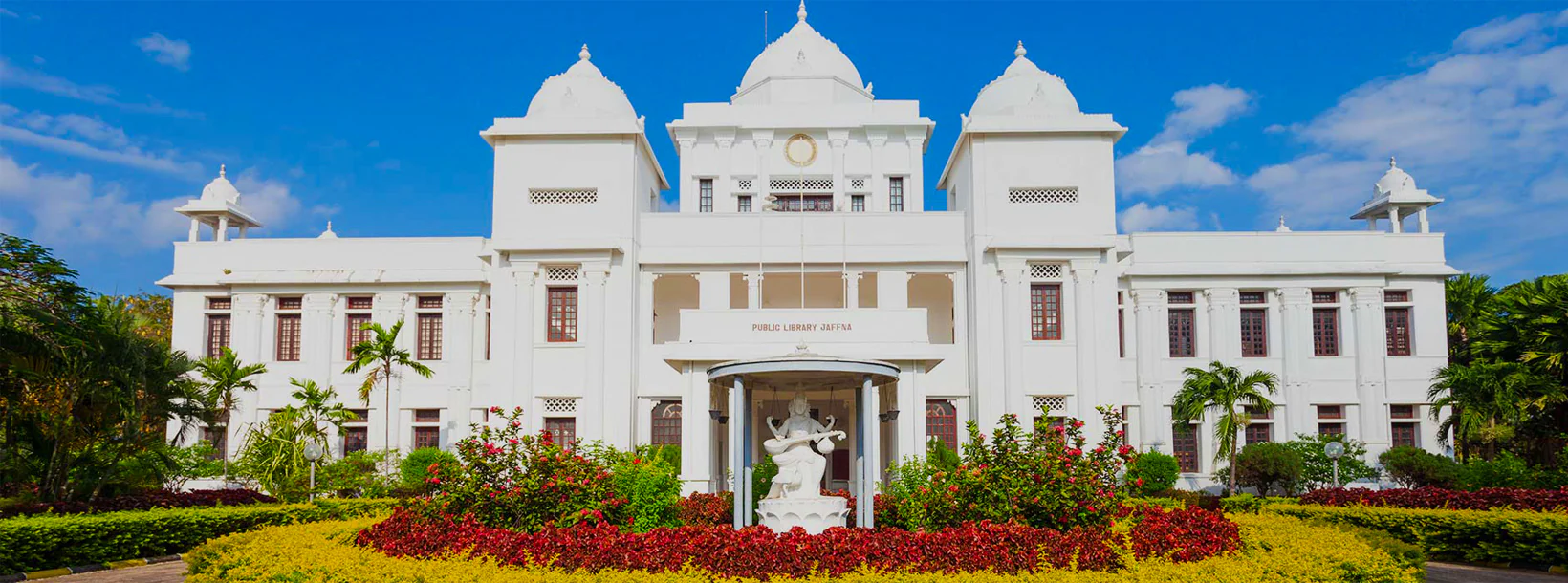
Jaffna City
Jaffna is the main city of Jaffna peninsula in the northernmost district of Sri Lanka. Comfortable intercity busses from Colombo take 10-12 hours to reach the city of Jaffna.
Jaffna
Jaffna es la principal ciudad de la península de Jaffna, en el distrito más septentrional de Sri Lanka. Los cómodos autobuses interurbanos desde Colombo tardan entre 10 y 12 horas en llegar a la ciudad de Jaffna.
La Marina de Sri Lanka ofrece un servicio de barcos de pasajeros desde la península de Jaffna hasta la isla de Nagadeepa, donde se encuentra el antiguo templo budista de Nagadeepa.
Acerca del distrito de Jaffna
Jaffna es la capital de la provincia del Norte de Sri Lanka. El 85% de la población de los distritos de Jaffna y Kilinochchi son hindúes. Los hindúes siguen la tradición saivita. El resto son en su mayoría católicos romanos o protestantes, algunos de los cuales son descendientes de colonos coloniales, conocidos como burgueses. Los tamiles están divididos por castas, y la casta campesina Vellalar constituye la mayoría. Los productos del mar, la cebolla roja y el tabaco son los principales productos de Jaffna.
Jaffna alberga hermosos templos hindúes. Aún se conserva un antiguo fuerte holandés dentro del cual hay una antigua iglesia. Otro ejemplo de arquitectura holandesa es la Casa del Rey. Ninguna visita a Jaffna está completa sin probar el exquisito mango de Jaffna, famoso por su dulzura. A unos 3 km se encuentra el majestuoso templo de Nallur Kandaswamy, sede del mayor festival religioso de Jaffna. El puerto de Kayts es un antiguo atraque de barcos en la región de Jaffna.
Acerca de Northern Province
La Provincia del Norte es una de las 9 provincias de Sri Lanka. Las provincias existen desde el siglo XIX, pero no tuvieron ningún estatus legal hasta 1987, cuando la 13ª enmienda a la Constitución de 1978 de Sri Lanka estableció los consejos provinciales. Entre 1988 y 2006, la provincia se fusionó temporalmente con la Provincia Oriental para formar la Provincia del Noreste. La capital de la provincia es Jaffna.
La Provincia del Norte se encuentra en el norte de Sri Lanka y está a solo 22 millas (35 km) de la India. La provincia está rodeada por el Golfo de Mannar y la bahía de Palk al oeste, el estrecho de Palk al norte, la bahía de Bengala al este y las provincias del Este, Norte Central y Noroeste al sur. La provincia tiene varias lagunas, siendo las más grandes la laguna de Jaffna, Nanthi Kadal, la laguna de Chundikkulam, la laguna de Vadamarachchi, la laguna de Uppu Aru, la laguna de Kokkilai, la laguna de Nai Aru y Chalé Laguna de Aai. La mayoría de las islas que rodean Sri Lanka se encuentran al oeste de la provincia del Norte. Las islas más grandes son: Kayts, Neduntivu, Karaitivu, Pungudutivu y Mandativu.
La población de la Provincia del Norte era de 1.311.776 en 2007. La mayoría de las poblaciones son tamiles de Sri Lanka, con una minoría de moros y cingaleses de Sri Lanka. El tamil de Sri Lanka es el idioma principal que habla en la provincia la gran mayoría de la población. El otro idioma que habla es el cingalés por el 1 por ciento de la población. El inglés se habla y se entiende ampliamente en las ciudades.
About Jaffna District
Jaffna is the capital city of the Northern Province, Sri Lanka. 85% of the populations of the Jaffna and Kilinochchi districts are Hindus. The Hindus follow the Saivite tradition. The remainders are largely Roman Catholics or Protestants, some of whom are descendants of colonial settlers, known as Burghers. The Tamils are divided along caste lines, with the farmer-caste Vellalar forming the majority. Sea products, red onion, and tobacco are the main products in Jaffna.
Jaffna is home to beautiful Hindu temples. An Old Dutch Fort still stands well preserved within which is an old Church. Another example of Dutch architecture is the King's House. No visit to Jaffna is complete without tasting the exquisite Jaffna mango, reputed for its sweetness. About 3 km away is the majestic Nallur Kandaswamy Temple, home to the largest religious festival in Jaffna. The Kayts Harbour is an ancient ship docking site in the Jaffna region.
About Northern Province
The Northern Province is one of the 9 provinces of Sri Lanka. The provinces have existed since the 19th century but they didn't have any legal status until 1987 when the 13th Amendment to the 1978 Constitution of Sri Lanka established provincial councils. Between 1988 and 2006 the province was temporarily merged with the Eastern Province to form the North-East Province. The capital of the province is Jaffna.
Northern Province is located in the north of Sri Lanka and is just 22 miles (35 km) from India. The province is surrounded by the Gulf of Mannar and Palk Bay to the west, Palk Strait to the north, the Bay of Bengal to the east and the Eastern, North Central and North Western provinces to the south.The province has a number of lagoons, the largest being Jaffna Lagoon, Nanthi Kadal, Chundikkulam Lagoon, Vadamarachchi Lagoon, Uppu Aru Lagoon, Kokkilai lagoon, Nai Aru Lagoon and Chalai Lagoon.Most of the islands around Sri Lanka are to be found to the west of the Northern Province. The largest islands are: Kayts, Neduntivu, Karaitivu, Pungudutivu and Mandativu.
The Northern Province's population was 1,311,776 in 2007. The majority of the populations are Sri Lankan Tamils, with a minority Sri Lankan Moor and Sinhalese population. Sri Lankan Tamil is the major language spoken in the province by the vast majority of the population. The other language spoken is Sinhala by 1 percent of the population. English is widely spoken and understood in the cities.














